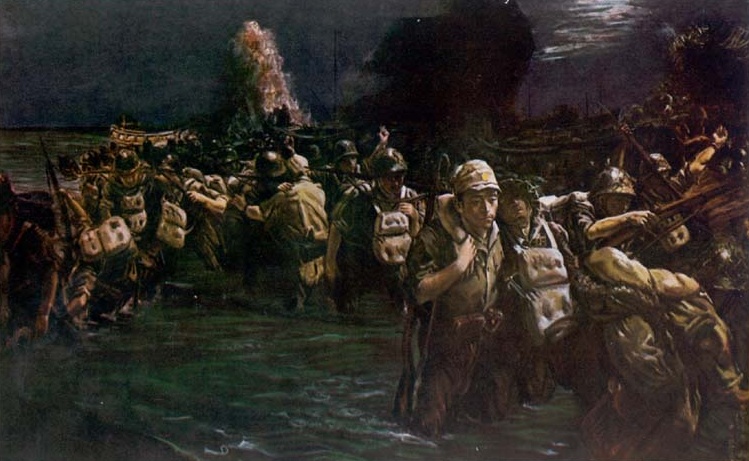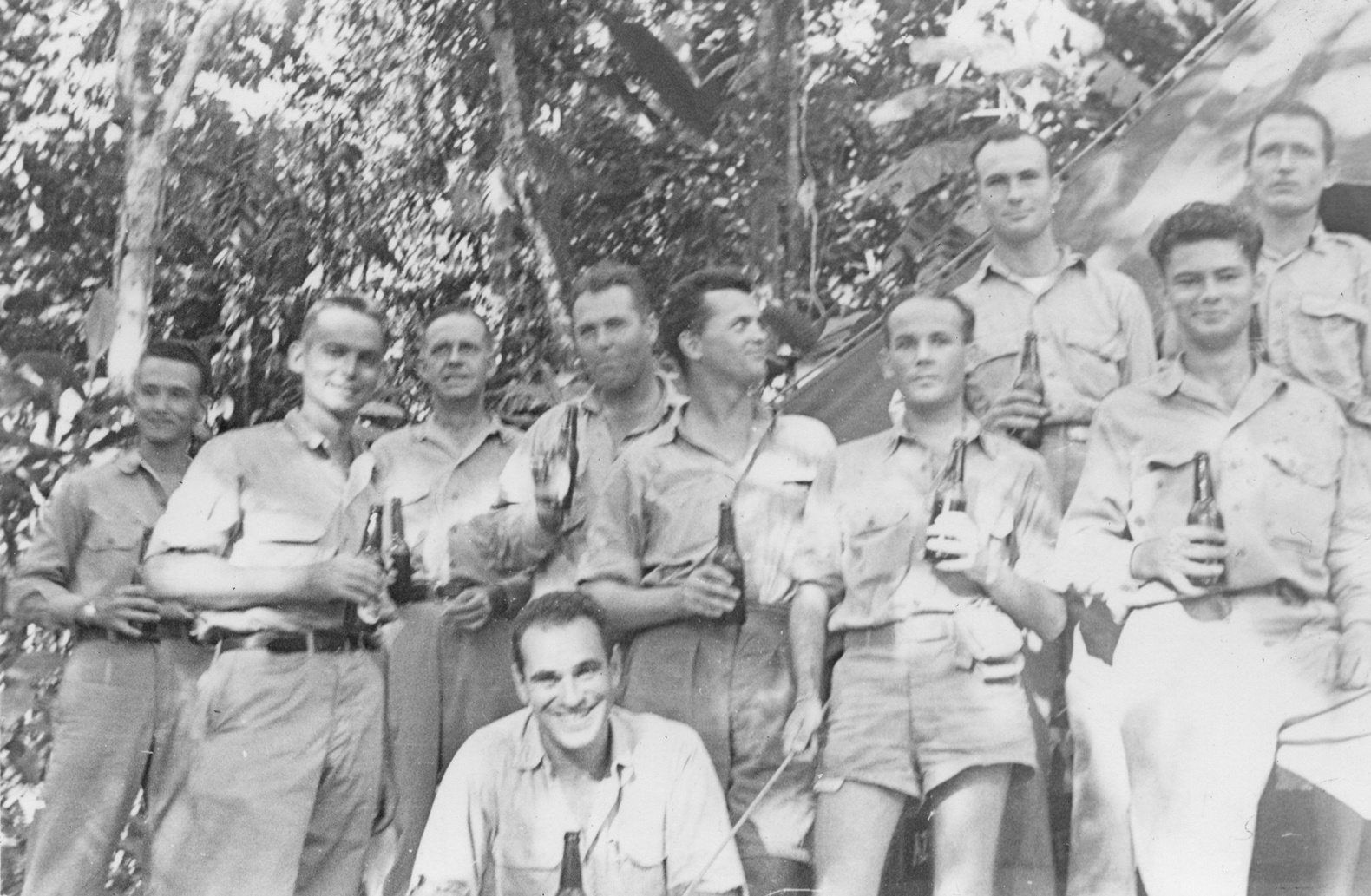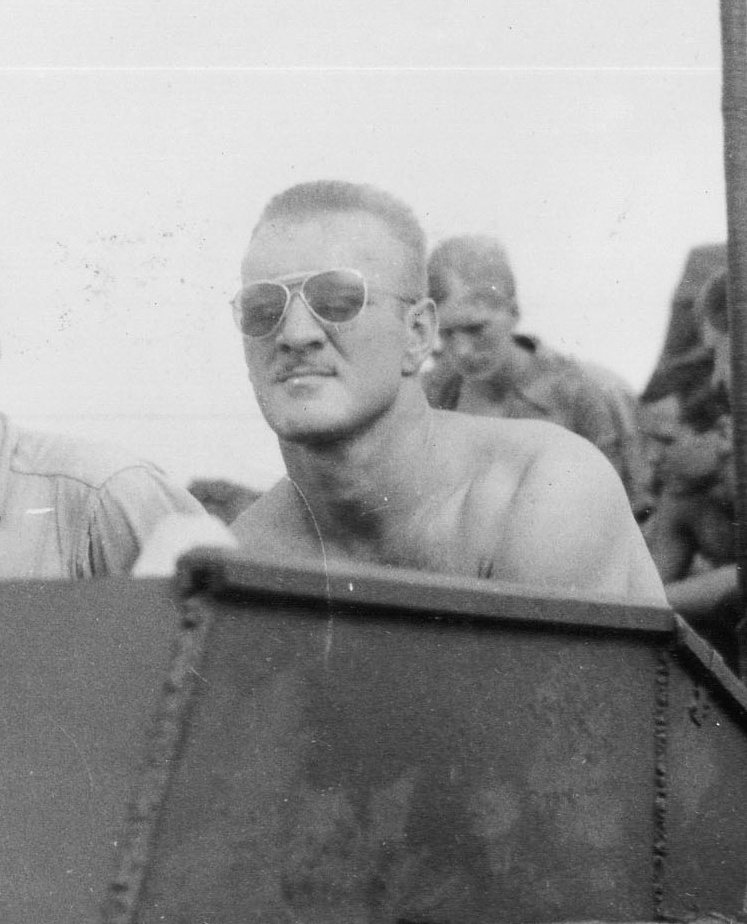|
br>

The Tulagi PT base. (PT Boats, Inc.)
Chapter Five: After Guadalcanal
Rollin Westholm's days as 109's skipper, as well as being a PT squadron commander were fast coming to a close. On February 1, orders came through transferring the lieutenant to the Flotilla One staff. Westholm was made the flotilla operations officer as well as the chief-of-staff to the flotilla boss, Commander Calvert. Lieutenant Allen Harris relieved Westholm as Squadron Two's CO; but the soon to be ex-boat skipper and 'squad dog' would have one more mission against the Tokyo Express at 109's helm. Earlier that day air reconnaissance and coastwatcher reports indicated that twenty Japanese destroyers were headed to Guadalcanal. To US Navy intelligence, it appeared that the Express was bringing in more troops to strengthen Japanese ground forces on the island, but this was a mistaken conclusion--the Express was now running in reverse. In late December the Japanese High Command, seeing that they had little hope in wresting control of Guadalcanal from the Americans, decided to secretly remove the remnants of their troops from the island, and this run was to be the beginning of three masterfully conducted evacuation operations from what the Japanese soldiers were beginning to call 'Starvation Island'. This odious reference to Guadalcanal by the Japanese found its origin in destruction of vital foodstuffs and other supplies by aircraft and PT's; the soldiers of Nippon found their bodies now gaunt and near skeletal from lack of food, and wracked with disease from a shortage of medicines.
Ninety-two American aircraft--fighters, torpedo planes, and dive-bombers from Henderson Field attacked the Japanese on the afternoon of February 1. The US pilots vigorously pressed home their attacks in the face of stiff aerial opposition and tremendous anti-aircraft defense; but were successful in damaging only one destroyer. The remaining nineteen ships kept going until they met the PT patrol between Guadalcanal and Savo. Westholm took the 109 off Lunga Point on Guadalcanal in company with Charlie Tilden in PT 36; as the two boats headed to their patrol station, the boat crews observed the PT patrol near Savo being strafed by a floatplane. The two boats arrived on station at 2215; an hour later they shifted their position to east of Savo after receiving the word the Express was headed for Esperance. Neither Westholm nor Tilden encountered any Japanese ships; the two crews saw three burning objects on the water they believed were enemy warships, but they turned out instead to be the funeral pyres of three priceless PT boats. Squadron Two's PT 111 commanded by Lieutenant Clagett took a direct hit from destroyer Kawakaze and was demolished. One man died in the water before rescue; one officer was missing. Squadron Three's PT 37 was another unfortunate recipient of good Japanese gunnery; with Squadron Two's Ensign James J. Kelly and a makeshift crew aboard, a five inch shell from an unseen Japanese destroyer penetrated the 37's gasoline tanks, igniting the highly flammable 100 octane fuel within. The titanic explosion of both shell and gasoline created a enormous fireball that lit up the entire Cape Esperance area; everything forward of 37's engine room was vaporized in a blaze of fire and smoke, while the stern section rapidly began to sink. The machinist's mate on duty in the engine room miraculously survived, with extensive shrapnel wounds and burns--all others aboard perished. Ensign Ralph Richards in his borrowed PT 123 of Squadron Six was surprised by an R Area Air Force floatplane that made probably the luckiest hit of the war. Cutting its engine, the Pete glided downwards and dropped a bomb on the 123's fantail, killing one man and seriously wounding three others. Three other sailors, all engine room personnel, were never seen again.
The Japanese destroyer Makigumo was the only definite sinking in this action, victim of either a torpedo from Lieutenant Faulkner's PT 124 or a mine planted by American minelayers earlier in the day. The crews of the 36 and 109 watched Makigumo sink at 0310 on the morning of the 2nd; one hour later, the two boats began the grim task of searching for survivors and missing PT's. At 0620, they found Ensign Bartholomew J. Connolly III's PT 115, along with PT 48 aground on Savo. The 109 pulled Connolly's 115 off the beach at 0640, and the 48 was freed twenty minutes later. After this was done, Westholm resumed his search for other survivors, but only found the dead body of Chief Gunner's Mate John J. Brown. The chief's body was badly burned, whith many shrapnel wounds; later the body was transferred to PT 36 for transportation to Tulagi, while 109 continued searching for two more hours until Westholm terminated it at 1115 without finding any other survivors.

The Japanese evacuation of Guadalcanal. Original painting by Kenichi Nakamura. (US Army Center of Military History)
The night of February 1/2 would be the last battle the Tulagi PT's would have with the Tokyo Express, and it was their most violent engagement of the entire campaign. The Imperial Navy made two more evacuation runs on the nights of February 4/5 and 6/7, but because of the heavy losses from the battle with the 'Evacuation Express' the PT's were not ordered out; but planes from Henderson Field were not idle, and attacked the Japanese ships on both occasions, leaving two enemy destroyers with major damage. On Guadalcanal itself, the fighting was nearing its end as US Army units (who relieved most of the original Marine amphibious force in December) spent the final days eliminating the last few pockets of Nipponese resistance. Although still unaware that the Japanese plan was evacuation, not reinforcement (because of good deception tactics and heavy opposition from Japanese rear-guard units) it was soon becoming evident as American troops pushed forward towards Cape Esperance, driving the Japanese from their remaining positions, that they were gaining the upper hand. On February 9, 1943, Major General Alexander M. Patch, commander of US ground forces on the islandGuaudalcanal, sent a message to Adm. William F. Halsey, Commander, South Pacific Force--'Total and complete defeat of Japanese forces on Guadalcanal effected 1625 today'.the Tokyo Express no longer has a terminus on Guadalcanal.' After six months of the most terrible fighting of the Pacific War to date, on land, in the air, and at sea, Guadalcanal was now in the possession of the United States. The Rising Sun of Imperial Japan, which had shone so brightly at the beginning of the war when the Japanese were winning victory after victory--was beginning to dim from the first dark shadows of defeat. But it would still take many more months of blood, sweat, and sacrifice from American and Allied soldiers, sailors, airmen, and Marines before it completely set in the Solomons.

The MTB Flotilla One staff share a lighter moment. The flotilla commander, Comdr Allen P. Calvert USN, is third from left. To the right of the commander is Lieutenant Westholm. (PT Boats, Inc.)
For the next four months, the PT sailors would enjoy a period of comparative calm. The Japanese spent the time reorganizing their holdings in the northern Solomons, and attempted no offensive action with their surface ships. With Lieutenant Westholm transferred to the Flotilla One staff, command of 109 passed back to Bud Larson, and the boat's missions at this time were relatively quiet:
February 6: delivered medical supplies to Army troops on Savo Island.
February 13: took a party to where PT 43 had beached itself the previous month. Flotilla One personnel and Commander Calvert surveyed the damaged PT to see if it could be repaired, but found the boat was beyond salvage.
February 17: Ensign Samuel K. King from MTB Division 23 reported aboard as the boat's new exec.
February 20/21: the occupation of the Russell Islands, located thirty-five miles west of Savo. Prior to the invasion, the 109 was assigned a scouting mission. The drill was as follows: to leave Tulagi at dusk, head for the Russells, find (in the dark) a certain cove off a particular bay to rendezvous with the Marine scouts (who had been placed in the area by another PT) and bring the scouts' CO back to Guadalcanal to deliver his report.
According to Bud Larson:
'It was a navigational challenge using dead reckoning and coastal piloting skills. Running entirely after dark from start to finish, we picked up and delivered the CO to Guad (Guadalcanal) on schedule. Hairy at times, but very satisfying.'
The night before the invasion, PT 109 and the other boats of Squadron Two screened the transport force headed to the Russells; thereafter the PT's made nightly patrols around the islands, but aside from the usual contretemps with floatplanes, the boats had no contact with the Japanese.
One particularly bright, moonlit night, Ensign Larson was leading a two-boat section in 109; it was a typical patrol for the boats working out of the Russells, a 'milk run'. Then Cactus Control sent a coded message to the PT's that meant action was imminent. As Larson decoded the message, the first words were 'two DD's (destroyers) sighted'; then a position was given that placed them very close to the PT's. The position reported was so close that Larson ran out of the charthouse to the cockpit to see if he could spot the enemy vessels visually. On such a moonlit night a PT boat tangling with Japanese warships was tantamount to a suicide mission. After sweeping the sea with his binoculars, it dawned on Larson and his crew that the coastwatcher that had sent the initial report to Cactus Control had spotted the two torpedo boats in the moonlight and had identified them as the 'two destroyers'.
As it turned out, this was Larson's last combat patrol in the Solomons; the Squadron Two boats were pulled out of the Russells in March 1943, shortly after Larson's moonlight escapade, and were relieved by boats of Squadron Six. Squadron Two returned to Tulagi to have their boats overhauled; as the land fighting continued up the Solomons chain, the original PT base was becoming a quiet backwater of the war, save for the occasional nuisance raid from Washing Machine Charlie or Louie the Louse. One of these raids, on the night of March 5, 'the Louse' dropped four bombs on Sesapi. The first three landed in the water while the fourth hit the PT operations shack, killing one officer and three enlisted men and seriously wounding another officer and another enlisted man. The hull of PT 118 moored nearby was holed with shrapnel. Some of 109's days in March were spent in dry dock; her mufflers were changed, and the boat's bottom was scraped of the green marine growth that accumulated there. Another test involving a radar set was made on March 15, but this one proved to be a bust; the set's power supply was quite unreliable and was prone to fail at any given moment, and it was removed shortly afterwards. On April 1st, Ensign King was transferred to another boat; replacing him was Leonard J. Thom, a big, blond haired native of Sandusky, Ohio. Described as 'a capable and warmhearted giant, who looked like a Viking who had lost his way and sailed into the South Pacific by mistake', 'Lenny' Thom personified the new breed of officer coming into the torpedo-boat corps at that time--former collegiate athletes that possessed the rough, tough, robust physiques to match; and 109's new exec still looked like the football player he had been before the war when he played left tackle at Ohio State in 1939 and 1940.

Ens. Leonard J. Thom, USNR (National Archives)
The Guadalcanal-Tulagi area was subjected to another air raid on April 7; it was the heaviest aerial bombardment staged by the Japanese since they were run off the island in February. 177 enemy aircraft were over the area, with one flight of dive-bombers particularly hell-bent on attacking anything moving in Tulagi Harbor. The New Zealand corvette Moa was hit by two bombs, and rapidly sank in four minutes. Other victims of the raid were destroyer Aaron Ward and oiler Kanawha. Of the twenty-five Japanese aircraft shot down in this raid, PT tender Niagara claimed seven; another enemy aircraft was shot down in flames by one of 109's twin fifty-caliber mounts manned by Seaman James Bartlett.

At about the same time, under attack by nine Japanese dive-bombers, a small convoy was approaching Tulagi that included tank landing ship LST 449; on board were a group of Navy officers bound for various assignments in the combat area. Among the transients was a lieutenant j/g with orders to disembark at Tulagi and report to Squadron Two as a replacement. The newcomer was a quiet young man with an unassuming manner, spoke with what some called 'that funny Boston accent', possessed a mop of brown hair that seemed to resist combing, and was incredibly lean--looking at him one would think he was far too frail for the slam-bang demands of the PT service. Fresh from Stateside PT duty with the training center at Melville, the enemy aircraft overhead, their bombs falling around the ship, and the ship's gunners filling the air with bullets and shells in a valiant effort to bring them down, was the new arrival's quick introduction to warfare in the South Pacific.
Arriving at Sesapi several days later, the replacement served briefly as a temporary exec on George Wright's PT 47, learning the rules of PT life in the Solomons. After riding a few patrols to get accustomed to the nightly routine, Wright informed the PT brass that the newcomer was ready for a boat of his own. Flotilla operations officer Rollin Westholm (now a lieutenant commander) chose the boat the new man would take over. Bud Larson and most of his crew were due for rotation home, so Westholm decided that the 109--his old squadron flagship--would be assigned to the new skipper. Of the boat's original crew of two officers and nine enlisted men, only three remained: Larson, quartermaster Guy Manning, and torpedoman Jack Edgar. On the evening of April 20 these three, along with Roy Dunkin, George Lewis, William Jackson, James Bartlett, and William McMillan--were detached from duty, headed for two weeks rest and relaxation in Australia. Lenny Thom was left in temporary command, with a skeleton force aboard. For the next five days, the PT 109 spent most of the time moored in the bushes along the banks of the Maliali River on Florida Island, occasionally shifting berths to take on water or fuel. On the morning of April 25, Ensign Thom took the boat to Sesapi to pick up 109's new CO--a twenty-six year-old product of Harvard who introduced himself to Thom as Jack Kennedy. That same day, the men who would make up the nucleus of the 109's new crew--Firemen Edmund Drewitch and Leon Drawdy, and Gunner's Mate Charles Harris--also reported to the boat. The rest of the new crew--sailors with names like Maguire, Kirksey, Galeweski, Kowal, Mauer, Burchheit, and McMahon--reported for duty within the next two weeks. For some, their stay aboard 109 would be brief; either transferred to other boats, or wounded in action and sent to hospital. Those who remained would sail with the boat throughout the late spring and into the summer of 1943--until the 109 met her ultimate fate on a dark, dangerous August night. But that was in the future; for now, five months of conntinuous patrolling left the 109 in serious need of major maintenance. New engines were needed, and the entire boat needed to be camouflaged in green to match the surrounding jungle, a job the previous crew had no time for when the boat originally arrived in the Solomons. Mr. Kennedy, Mr. Thom, and 109's new crew rolled up their sleeves and set to the task of refurbishing the tired old veteran, and in the process, the boat's officers had the additional duty of forging the new men into a team ready for the challenges to come. With the departure of Bryant Larson and the remnants of the boat's original crew, a little-known phase of PT 109's career now comes to a close; with the arrival of John Kennedy a new and more heralded chapter was about to begin.

The crew of PT 109, sometime in July 1943. Top row, left to right: Al Webb (standing far left, friend of the crew), MoMM2/c Leon E. Drawdy, S1/c Edgar E. Mauer, MoMM2/c Edmund T. Drewitch, RM2/c John E. Maguire, Lt. j/g John F. Kennedy (standing far right). Bottom row, left to right: GM2/c Charles A. Harris, GM3/c Maurice L. Kowal, TM2/c Andrew J. Kirksey, Ens. Leonard J. Thom.
|
|
|
|
Copyright © 2002-2013 by Gene Kirkland
|